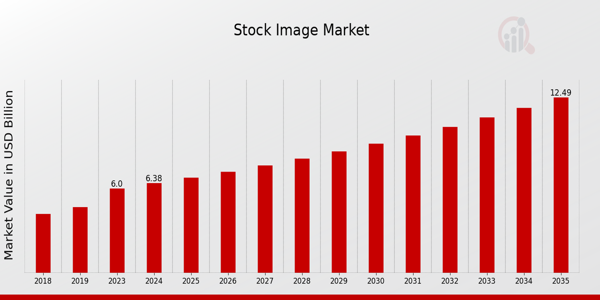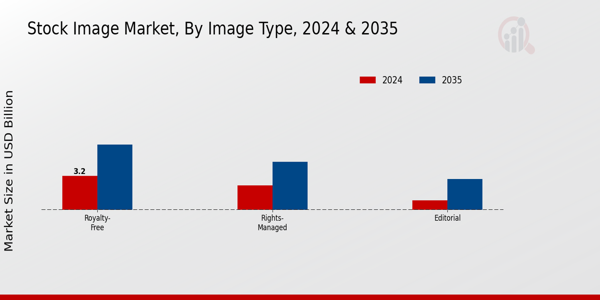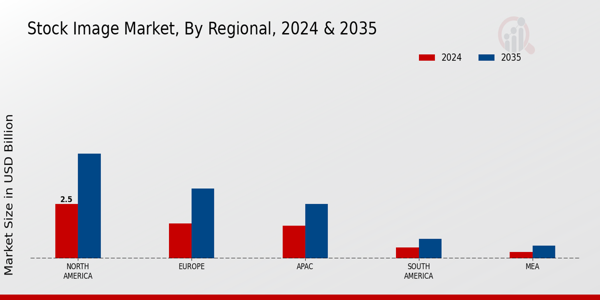Stock Image Market Overview
As per MRFR analysis, the Stock Image Market Size was estimated at 6.0 (USD Billion) in 2023. The Stock Image Market Industry is expected to grow from 6.38 (USD Billion) in 2024 to 12.5 (USD Billion) by 2035. The Stock Image Market CAGR (growth rate) is expected to be around 6.3% during the forecast period (2025 - 2035).
Key Stock Image Market Trends Highlighted
The Stock Image Market is undergoing important transformations due to some particular factors. The growing need for visual materials on digital channels has emerged as one of the leading factors in the market. Companies are increasingly using stunning images to promote their flow of business, which in turn increases the purchase of stock images. Furthermore, the proliferation of social media and the rise of content marketing are encouraging brands to spend more on rich imagery. There has been a stronger tendency for users to seek more relevant and varying images to use in marketing campaigns, websites and social media posts. New opportunities that may be tapped into are the emergence of specialized stock images and niche markets.
As more creators and businesses look for unique content that aligns with their brand identity, providers that cater to specific themes, lifestyle choices, or cultural elements can gain a competitive edge. Furthermore, advancements in AI and machine learning present a chance to enhance the user experience by offering tailored recommendations and improved search functionalities. As more organizations prioritize authenticity and diversity in their marketing efforts, stock image providers can tap into this demand by presenting a broader range of representations. Trends in recent times suggest an increasing shift toward subscription-based models in the stock image market, making access to extensive libraries easier for users.The emphasis on ethical sourcing and environmentally-conscious content is also gaining traction, prompting stock image companies to be more mindful in their practices. The rise in DIY content creation and the need for high-quality visuals in user-generated content reflects a broader movement toward accessibility and convenience. As the landscape continues to evolve, these market dynamics reveal the ongoing transformation within the Stock Image Market, pushing the boundaries of creativity and innovation.

Source: Primary Research, Secondary Research, MRFR Database and Analyst Review
Stock Image Market Drivers
Increasing Demand for Visual Content in Digital Marketing
The surge in the Stock Image Market Industry can be primarily attributed to the increasing demand for visual content in digital marketing. As businesses pivot towards online platforms to reach customers, the importance of high-quality images has never been more critical. The rise of social media, where visual storytelling is paramount, has fueled the need for stock images that resonate with target audiences.
Advertisers and marketers recognize that compelling visuals can significantly enhance engagement rates, conversion rates, and brand visibility.Across various industries, from e-commerce to travel, the strategic use of stock images helps convey messages more effectively than text alone. With escalating competition in the digital realm, the need for businesses to differentiate themselves through impactful visuals is driving the stock image market's growth. Furthermore, advancements in technology enable easier access to vast libraries of stock images, making it more feasible for businesses of all sizes to integrate professional-quality visuals into their marketing strategies.
In this context, the demand for fresh, culturally relevant, and diverse imagery has prompted stock image providers to innovate continually, offering a wider range of options to meet specific client needs. Consequently, this dynamic is pushing the Stock Image Market Industry forward as companies increasingly allocate budgets toward procuring high-quality stock images.
Growth of Social Media and User-Generated Content
The rise of social media platforms has transformed the way content is created and shared, influencing the Stock Image Market Industry significantly. With billions of users generating and consuming content daily, there is a pressing need for high-quality visual assets. Brands and influencers require stock images to maintain aesthetic appeal on their profiles and marketing campaigns, necessitating continuous access to diverse imagery. This ongoing demand stimulates the growth of stock image providers who cater to social media trends and audience preferences.
Expansion of E-commerce and Online Businesses
As e-commerce continues to expand globally, the need for visually appealing content has become critical in attracting consumers. Online businesses rely heavily on imagery to showcase products effectively, enhance user experience, and create emotional connections with potential buyers. The Stock Image Market Industry stands to benefit as retailers seek quality visuals to stay competitive, driving increased investment in stock images.
Stock Image Market Segment Insights
Stock Image Market Image Type Insights
The Image Type segment of the Stock Image Market represents a critical area for understanding its ongoing trends and growth patterns, with significant contributions from various categories. In 2024, the overall valuation of this segment stood at approximately 6.38 USD Billion, showcasing a diverse structure among its picture types. The majority of this market revenue stems from the Royalty-Free category, which commands a noteworthy valuation of 3.2 USD Billion. Its appeal lies in the flexible licensing model that allows buyers to use images without worrying about additional fees, making it particularly attractive to businesses and content creators.
Following closely is the Rights-Managed category, with a valuation of 2.3 USD Billion. This type of imagery offers more specificity and control, ensuring precise usage based on the terms agreed upon, thus appealing to users looking for exclusivity or tailored rights for their projects. Meanwhile, the Editorial segment, albeit the smallest, records a valuation of 0.88 USD Billion, serving a niche market where images are primarily used for news and current events, emphasizing contemporary relevance while adhering to strict usage guidelines.
By 2035, the overall image type segment is expected to grow, reaching values of 6.1 USD Billion for Royalty-Free, 4.5 USD Billion for Rights-Managed, and 2.9 USD Billion for the Editorial category. This growth signifies a sustained demand for visual content across digital platforms, fueled by the rise of social media marketing, e-commerce, and an increase in online publishing. The Stock Image Market data demonstrates that the Royalty-Free category significantly dominates the market, capturing the largest share due to its practicality and economic efficiency, which drives its adoption across multiple sectors. In contrast, the Rights-Managed category's significance lies in its structured licensing approach, providing a critical service to businesses that require high-quality, exclusive images while addressing legal concerns around copyright.
The Editorial images, although representing a smaller segment, play an essential role in modern journalism and media by providing fresh and real-time visuals that enhance storytelling and engagement. The Stock Image Market industry thus faces promising opportunities but also challenges, particularly in maintaining quality and meeting the diverse needs of users. As digital consumption grows, each category within the Image Type segment must evolve and adapt, strategically positioning itself to capture the changing demands of the marketplace while ensuring compliance with legal frameworks governing image use. This dynamic landscape ensures that the image type segment remains a vital component of the overall Stock Image Market statistics, demonstrating robust growth potential and various pathways to success in the coming years.

Source: Primary Research, Secondary Research, MRFR Database and Analyst Review
Stock Image Market Application Insights
The Stock Image Market, particularly in the Application segment, is a dynamic and essential arena valued at 6.38 billion USD by 2024, with substantial growth anticipated in the coming years. This segment encompasses various crucial categories, including Advertising, Publishing, Web Design, and Social Media. Advertising holds a significant position as businesses increasingly rely on visually striking content to capture consumer attention and drive engagement. Publishing is also vital, supporting diverse media outlets in delivering visually appealing narratives.
Web Design benefits significantly from stock images, as high-quality visuals enhance user experience and site aesthetics. Social Media thrives on captivating images that encourage interactions and shares, making stock image utilization pivotal in this digital landscape. The overall market benefits from ongoing digital transformation and the growing need for high-quality visual content across various platforms, thus propelling the Stock Image Market revenue and influencing trends. Market growth in this sector is further supported by the increasing demand for diverse and adaptable image content to cater to various consumer preferences.
Stock Image Market End User Insights
In 2024, the Stock Image Market revenue reached 6.38 USD Billion, reflecting the growing importance of various End Users such as Individuals, Small Enterprises, Large Enterprises, and Agencies. This segment plays a crucial role in shaping the dynamics of the Stock Image Market. Individuals often rely on stock images for personal projects or social media use, while Small Enterprises utilize affordable stock images for marketing efforts, enabling their growth and visibility in competitive markets. Large Enterprises dominate this segment due to their extensive marketing and advertising needs, often incorporating high-quality visuals into their branding strategies.
Agencies serve as significant players, sourcing stock images for diverse clients, which enhances their service offerings and overall market reach. The Stock Image Market statistics indicate a steady increase in demand among different End Users, driven by the growing digitization of content and the need for visually appealing materials. However, challenges such as copyright issues and the oversaturation of visuals in the market pose concerns that stakeholders need to address to tap into the emerging opportunities and trends effectively.
Stock Image Market Content Type Insights
The Content-Type segment within the Stock Image Market has become increasingly vital as various industries continue to seek engaging visual content. In 2024, the valuation of the Stock Image Market reached 6.38 billion USD, and this growth trend signifies an increasing demand for high-quality visual assets. Among the different content types, photographs hold a significant portion of the market, primarily due to their versatility in applications ranging from advertising to social media. Illustrations and vectors also contribute considerably, catering to creative and marketing needs for brands looking for unique visual representation.
Videos have started to dominate the landscape as well, fueled by the rise of digital platforms and the necessity for more dynamic and engaging storytelling. The growth in this segment is influenced by trends such as the increasing consumption of visual content and the proliferation of online marketing efforts, which require a steady supply of diverse media formats. However, challenges such as copyright issues and the saturation of stock images demand innovation for differentiation. Overall, the Stock Image Market data reflects a robust landscape driven by the diverse needs for content across multiple sectors.
Stock Image Market Regional Insights
The Stock Image Market is segmented regionally with significant variations across different areas. In 2024, North America dominated this market with a valuation of 2.5 USD Billion, reflecting its leading role in digital content creation and consumption, projected to reach 4.8 USD Billion by 2035. Europe follows, valued at 1.6 USD Billion in 2024 and growing to 3.2 USD Billion, showcasing robust demand for stock images across diverse sectors, including advertising and media.
The APAC region is also notable, with a valuation of 1.5 USD Billion in 2024, anticipating a rise to 2.5 USD Billion, driven by increasing internet penetration and mobile usage.Meanwhile, South America and MEA are comparatively smaller contributors, valued at 0.5 USD Billion and 0.3 USD Billion in 2024, respectively, with growth to 0.9 USD Billion and 0.6 USD Billion by 2035. Although these markets are emerging, they present opportunities for growth as digital marketing expands. The Stock Image Market statistics display a clear trend of increasing revenue across all regions, with North America holding the majority share, driven by a well-established digital ecosystem.

Source: Primary Research, Secondary Research, MRFR Database and Analyst Review
Stock Image Market Key Players and Competitive Insights
The Stock Image Market has seen substantial growth in recent years, driven by the increasing demand for high-quality visual content across various media platforms. With the rise of digital marketing, social media, and online content creation, businesses of all sizes are seeking to enhance their visual communication through stock imagery. A diverse array of companies marks this competitive landscape, each vying for market share while offering unique value propositions. Factors influencing competition include pricing strategies, the breadth and quality of image collections, innovative subscription models, and customer engagement and support.
As technology continues to evolve, the need for optimization and refined offerings in the stock image industry becomes increasingly vital, resulting in dynamic competition among market players.Shutterstock has established a strong foothold in the Stock Image Market through its vast collection of high-resolution images, videos, and music. The company's focus on delivering quality content is complemented by an intuitive user interface that enhances the customer experience. Shutterstock's strength lies in its extensive community of contributors, providing an unrivaled diversity of images that cater to a wide array of industries and creative projects.
The platform's robust search functionalities, asset management tools, and flexible subscription options empower users to find and utilize visuals efficiently. Moreover, Shutterstock's ongoing investment in technology and data analytics helps ensure users receive personalized content suggestions and experiences tailored to their specific needs, further solidifying its position in a competitive market.iStock has carved out a niche within the Stock Image Market by emphasizing affordability and accessibility without sacrificing quality. As a part of a larger brand ecosystem, iStock benefits from enhanced visibility and trust among customers looking for stock imagery solutions.
This platform excels in offering a curated selection of images that cater specifically to small businesses, marketers, and creatives who seek compelling visuals at competitive prices. The company's strengths include a user-friendly platform and versatile pricing structures that accommodate varying budgets. Additionally, iStock's focus on trends and understanding customer preferences enables it to keep its collection relevant and appealing, thus attracting a steady flow of new users while retaining existing clients. This strategic positioning allows iStock to thrive amid increasing competition, making it a noteworthy player in the stock image marketplace.
Key Companies in the Stock Image Market Include
- Shutterstock
- iStock
- Stocksy
- Fotolia
- Picfair
- Pond5
- 123RF
- Dreamstime
- Adobe Stock
- Canva
- Getty Images
- Bigstock
- Envato
- Alamy
- Depositphotos
Stock Image Market Industry Developments
In the Stock Image Market, significant developments are emerging as companies like Shutterstock, Adobe Stock, and Getty Images continue to enhance their services and expand their portfolios. Shutterstock recently announced strategic integrations and enhancements to its platform, focusing on AI-driven content generation, which aims to streamline user experience and attract a broader audience. In contrast, Adobe Stock has been actively diversifying its offerings by incorporating high-quality illustrations and 3D assets, catering to designers' evolving needs. Getty Images also exhibited growth by expanding its exclusive content partnerships, increasing its competitive edge.
Mergers and acquisitions are shaping the landscape, with companies like Envato and Depositphotos exploring potential partnerships to broaden their audience bases. Moreover, with the rising importance of copyright compliance, platforms such as Picfair are enhancing transparency and affordability for creators, reflecting a market shift towards ethical sourcing. Overall, the stock image sector is witnessing a dynamic transformation, marked by technological advancements and strategic collaborations that significantly impact market valuation and consumer choices.
Stock Image Market Segmentation Insights
-
Stock Image Market Image Type Outlook
- Royalty-Free
- Rights-Managed
- Editorial
-
Stock Image Market Application Outlook
- Advertising
- Publishing
- Web Design
- Social Media
-
Stock Image Market End User Outlook
- Individuals
- Small Enterprises
- Large Enterprises
- Agencies
-
Stock Image Market Content Type Outlook
- Photographs
- Illustrations
- Vectors
- Videos
-
Stock Image Market Regional Outlook
- North America
- Europe
- South America
- Asia - Pacific
- Middle East and Africa
| Attribute/Metric Source: |
Details |
| MARKET SIZE 2023 |
6.0(USD Billion) |
| MARKET SIZE 2024 |
6.38(USD Billion) |
| MARKET SIZE 2035 |
12.5(USD Billion) |
| COMPOUND ANNUAL GROWTH RATE (CAGR) |
6.3% (2025 - 2035) |
| REPORT COVERAGE |
Revenue Forecast, Competitive Landscape, Growth Factors, and Trends |
| BASE YEAR |
2024 |
| MARKET FORECAST PERIOD |
2025 - 2035 |
| HISTORICAL DATA |
2019 - 2024 |
| MARKET FORECAST UNITS |
USD Billion |
| KEY COMPANIES PROFILED |
Shutterstock, iStock, Stocksy, Fotolia, Picfair, Pond5, 123RF, Dreamstime, Adobe Stock, Canva, Getty Images, Bigstock, Envato, Alamy, Depositphotos |
| SEGMENTS COVERED |
Image Type, Application, End User, Content Type, Regional |
| KEY MARKET OPPORTUNITIES |
Diversification of content types, Growth in e-commerce demand, Increasing use of social media, Expansion in virtual reality imagery, Demand for localized images |
| KEY MARKET DYNAMICS |
increasing demand for visual content, rise of digital marketing, growth of e-commerce platforms, advancements in technology, expanding freelance creator economy |
| COUNTRIES COVERED |
North America, Europe, APAC, South America, MEA |
Frequently Asked Questions (FAQ) :
The Global Stock Image Market is expected to be valued at 6.38 USD billion in 2024.
By 2035, the Global Stock Image Market is anticipated to reach a value of 12.5 USD billion.
The expected CAGR for the Global Stock Image Market from 2025 to 2035 is 6.3%.
North America holds the largest market share, valued at 2.5 USD billion in 2024.
The Royalty-Free segment of the Global Stock Image Market is valued at 3.2 USD billion in 2024.
Major players in the market include Shutterstock, iStock, Adobe Stock, and Getty Images.
The Editorial segment is projected to grow from 0.88 USD billion in 2024 to 2.9 USD billion by 2035.
The South American market for stock images is expected to grow from 0.5 USD billion in 2024 to 0.9 USD billion in 2035.
The Rights-Managed segment is valued at 2.3 USD billion in 2024 and is projected to reach 4.5 USD billion by 2035.
Emerging trends and shifts in digital media consumption are expected to drive significant growth in the Global Stock Image Market.

















